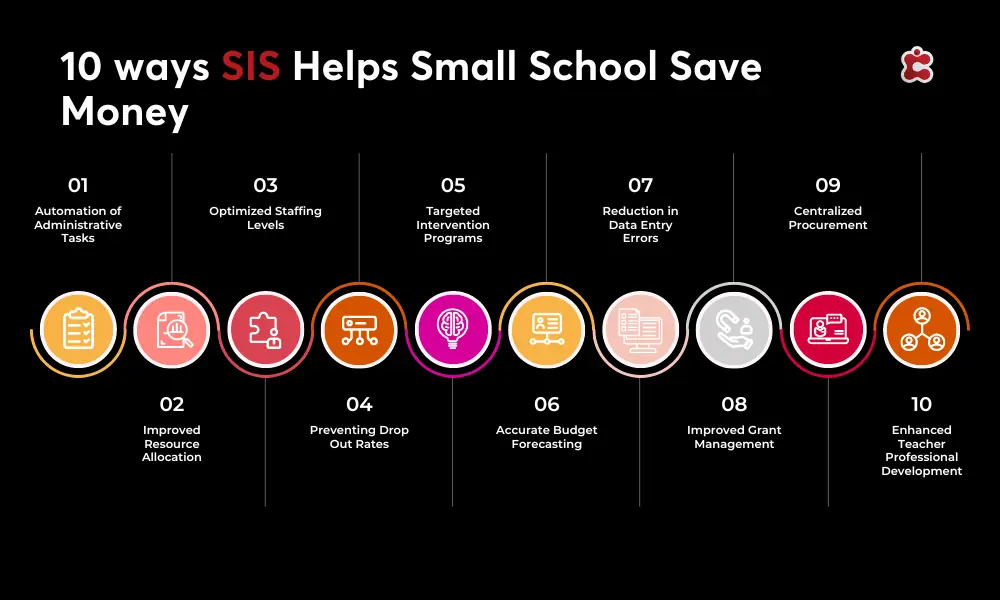Small schools have always played a big role in the education. With fewer than 200 students, these institutions foster tight-knit communities where every individual is known and valued. Small schools boast several advantages, including lower student-to-teacher ratios, flexibility in designing their curriculum to students’ needs, and higher levels of parent involvement. It’s no wonder that the number of small NAIS schools increased by 30% over the past 15 years. However, despite these strengths, small schools face unique challenges. Limited budgets, stretched resources, and administrative constraints can pose significant hurdles to their operation and growth. To address these challenges, small schools are increasingly turning to Student Information Systems (SIS). These systems offer tailored solutions designed to streamline administrative processes, optimize resources, and ultimately save money. This article explores 10 specific ways that small schools can leverage SIS to maximize their financial resources and thrive in an increasingly competitive educational environment.
What is a Student Information System and why does my Small School need it?
A Student Information System (SIS) is a comprehensive software platform designed to manage various aspects of student data and administrative tasks within educational institutions. It serves as a centralized hub for storing and accessing information. This information can be related to student demographics, enrollment, academic performance, and more. By consolidating disparate data sources into a single system, an SIS simplifies administrative processes, reduces manual workload, and minimizes errors. Small schools, in particular, can greatly benefit from implementing an SIS due to their limited resources and personnel.

1. Automation of Administrative Tasks
SIS can automate a wide range of administrative processes, including attendance tracking, report generation, grading, and scheduling. This automation significantly reduces the need for additional staffing or overtime hours, directly impacting payroll expenses. For instance, automated scheduling features optimize class schedules to minimize conflicts and maximize resource utilization. This leads to efficient use of staff and facilities without the need for expensive manual coordination. By automating these tasks, small schools can tangibly reduce operational costs, allowing them to allocate financial resources more effectively toward other critical areas.
2. Improved Resource Allocation
Improved resource allocation is a key aspect where SIS contributes significantly to saving money in small schools. These systems offer precise data on student demographics, academic performance, and behavior, which enable schools to make informed decisions regarding resource allocation. Schools can accurately identify areas of need, such as additional tutoring support for struggling students or targeted enrichment programs for high achievers. This prevents wasteful spending on ineffective interventions. Furthermore, SIS assists in identifying trends and patterns in student data, allowing schools to proactively allocate resources where they are most needed.
3. Optimized Staffing Levels
By leveraging data analytics capabilities, SIS enables schools to identify trends in student enrollment and academic needs accurately. This insight allows administrators to adjust staffing levels accordingly. For instance, if student enrollment trends indicate a decline in certain grade levels or subjects, schools can make informed decisions to reallocate staff or adjust hiring plans accordingly, avoiding unnecessary payroll expenses. Similarly, by identifying areas of high demand or specific academic support needs, schools can strategically deploy staff resources to maximize their impact.
4. Preventing Drop Out Rates
Preventing dropout rates is not only crucial for student success but also for saving money. Student Information Systems can effectively identify students at risk of dropping out through early warning systems. They analyze various indicators such as attendance records, academic performance, and behavior patterns. By detecting these warning signs early on, schools can intervene proactively and provide targeted support services to at-risk students. This proactive saves potential costs associated with dropout recovery programs, such as additional instructional support, counseling services, and alternative education programs.
5. Targeted Intervention Programs
As with reducing dropout rates, SIS excels in this area by leveraging data analysis to identify students who require additional support or intervention. The platform can pinpoint students who may be struggling academically or emotionally. This early identification enables schools to intervene proactively, providing targeted resources and support services to help these students succeed. Through the strategic allocation of resources facilitated by SIS, small schools can effectively support struggling students while minimizing the financial burdens.
6. Accurate Budget Forecasting
Budgeting is important at any institution, but especially in small schools where resources are often limited. Accurate budget forecasting is essential for financial stability and sustainability. Student Information Systems provides real-time data on student enrollment and demographic trends. With this information at their fingertips, administrators can make informed decisions about resource allocation, staffing, and program development. By predicting future expenses based on current enrollment numbers and trends, schools can avoid unexpected costs and budget shortfalls.

7. Reduction in Data Entry Errors
Operating with limited administrative staff is a common struggle small schools must face. SIS alleviates the burden of manual data entry by automating processes like student registration, grade recording, and attendance tracking. The elimination of repetitive data entry tasks reduces the likelihood of human errors in student records. These errors, if left uncorrected, can lead to various costly consequences, including misplacement of academic records, inaccuracies in grade reporting, and delays in communication with parents.
8. Improved Grant Management
Small schools often rely on grants to fund various programs and initiatives aimed at enhancing the educational experience for students. However, managing these grants efficiently can be challenging. With SIS, schools can easily track the allocation and utilization of grant funds, ensuring transparency and accountability in financial reporting. By centralizing grant-related data within the platform. Thus, administrators can monitor expenditures in real time, identify areas of overspending or underspending, and make informed decisions to optimize funding utilization.
9. Centralized Procurement
Sourcing educational resources and materials at affordable prices can be challenging. However, Student Information Systems offers a solution by facilitating centralized procurement processes. It consolidates purchasing activities in one space, which allows schools to leverage their collective buying power to negotiate better prices and discounts from vendors. This centralized approach not only streamlines the procurement process but also enables administrators to track expenditures more effectively and identify opportunities for cost-saving.
10. Enhanced Teacher Professional Development
In small schools, investing in teacher professional development is crucial for maintaining high-quality standards. However, identifying the most pertinent areas for improvement and allocating resources efficiently can be challenging. SIS offers a solution by providing comprehensive data analysis capabilities. By analyzing student performance data, attendance records, and assessment results, SIS can pinpoint areas where teachers may require additional training or support. This targeted approach to professional development ensures that resources are allocated effectively.
Want to help your institution save money and streamline operations?
Choose Classter as your Student Information System (SIS) solution. With Classter, small schools can benefit from comprehensive features that automate administrative tasks, optimize resource allocation, and enhance communication between stakeholders.
Talk to one of our experts and book a demo today.
FAQ’s
An SIS streamlines administrative processes, reduces manual workload, improves resource allocation, and provides insights for informed decision-making, all of which are particularly advantageous for small schools with limited resources.
Yes, a Student Information System typically includes features for parent portals, allowing parents to access their child’s academic progress, attendance records, and communication with teachers, fostering transparency and collaboration.
When choosing an SIS, consider factors such as scalability, ease of use, customization options, integration capabilities with existing systems, ongoing support, and total cost of ownership to ensure it aligns with your school’s unique needs and goals.

